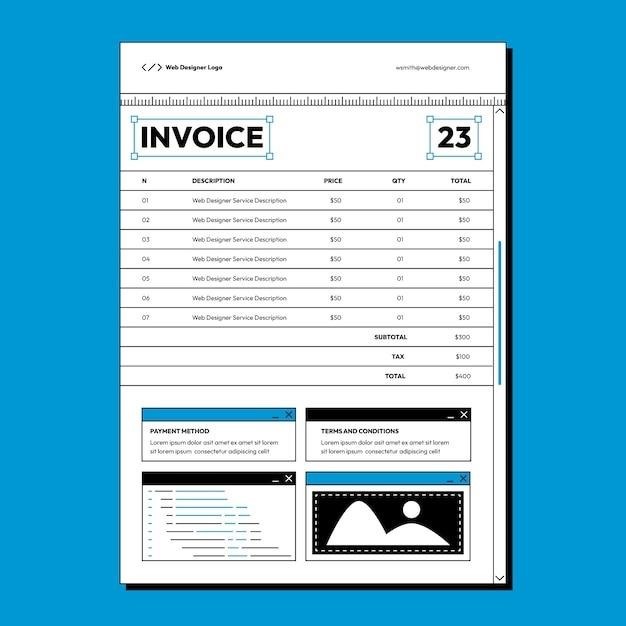Bank Statement PDF Sample⁚ A Comprehensive Guide
Bank statements are essential documents that provide a detailed record of your financial transactions. They are crucial for managing your finances effectively, tracking spending, reconciling accounts, and ensuring accurate record-keeping. This comprehensive guide will delve into the intricacies of bank statements, exploring their types, key components, importance, and how to effectively utilize them.
Understanding Bank Statements
A bank statement is a document that summarizes all the transactions that have occurred in a bank account over a specific period. It is a detailed record of deposits, withdrawals, payments, and other financial activities related to your account. Bank statements are typically issued monthly, although some banks may offer more frequent statements. They serve as a valuable tool for monitoring your financial health, tracking your spending patterns, and ensuring that your account balance is accurate.
Understanding your bank statement is crucial for managing your finances responsibly. It allows you to identify any discrepancies or errors, track your spending habits, and make informed financial decisions. By carefully reviewing your bank statement, you can gain valuable insights into your financial situation and take steps to improve your financial well-being.
Types of Bank Statements
Bank statements come in various formats depending on the type of account and the bank’s policies. Here are some common types of bank statements⁚
- Regular Bank Statements⁚ These are the most common type of bank statement, usually issued monthly. They provide a detailed summary of transactions, including deposits, withdrawals, payments, and interest earned or charged.
- Online Bank Statements⁚ Many banks offer online access to bank statements. These statements are typically available in PDF format, allowing you to download and save them for your records. Online statements often provide additional features, such as the ability to search transactions and filter by date or category.
- Statement of Account⁚ This type of statement is often used for accounts with a higher balance or specific investment products. It provides a more detailed overview of your account, including investment performance, interest accrual, and other relevant information.
- Consolidated Bank Statements⁚ If you have multiple accounts with the same bank, you may receive a consolidated bank statement that combines all your account activity into a single document.
The specific types of bank statements available may vary depending on your bank and account type. It’s essential to familiarize yourself with the types of statements your bank offers and how to access them.
Key Components of a Bank Statement
Bank statements contain essential information about your account activity and financial transactions. Understanding the key components of a bank statement will help you analyze your finances, track spending patterns, and identify any discrepancies. Here’s a breakdown of the typical components⁚
- Account Information⁚ This section includes details like your account number, account type (e.g., checking, savings), and the name of the financial institution. It’s crucial for verifying the accuracy of the statement and ensuring it pertains to your specific account.
- Statement Summary⁚ This section summarizes your account activity for the statement period. It typically includes the beginning balance, total deposits or credits, total withdrawals or debits, and the ending balance. This provides a quick overview of your account’s financial position.
- Transaction Details⁚ This is the core section of a bank statement, providing a chronological list of every transaction that occurred during the statement period. Each transaction entry includes the date, description, amount, and transaction type (e.g., deposit, withdrawal, transfer). Carefully reviewing this section allows you to track your spending, identify any unauthorized transactions, and reconcile your account balance.
These components are essential for understanding and managing your finances effectively.
Account Information
The Account Information section is the first crucial component of a bank statement, providing foundational details about your account. This section acts as a verification tool, ensuring the statement accurately reflects your financial activity. Here’s what you can typically find in the Account Information section⁚
- Account Holder Name⁚ This clearly identifies the individual or entity associated with the account. It’s important to verify that the name matches your own or your business’s name to ensure you’re reviewing the correct statement.
- Account Number⁚ This unique identifier is essential for distinguishing your account from others. It’s crucial for accurate record-keeping and for referencing your account in any communication with the financial institution.
- Account Type⁚ This specifies the type of account you hold, such as a checking, savings, or money market account. Understanding your account type helps interpret the transactions listed on the statement and track your financial activity correctly.
- Bank Name⁚ This clearly identifies the financial institution responsible for your account. It’s essential for confirming the source of the statement and ensuring you’re dealing with the correct institution.
By carefully reviewing this section, you can confirm the accuracy of the statement and ensure it pertains to your specific account.
Statement Summary
The Statement Summary provides a concise overview of your account’s financial status during the period covered by the statement. This section acts as a quick reference point, allowing you to grasp the key financial movements within your account at a glance. Here’s what typically comprises the Statement Summary⁚
- Beginning Balance⁚ This represents the amount of money in your account at the start of the statement period. It serves as the starting point for tracking your financial activity during the period.
- Ending Balance⁚ This reflects the amount of money remaining in your account at the end of the statement period. It provides a snapshot of your account’s current financial position.
- Total Deposits⁚ This summarizes the total amount of money deposited into your account during the statement period. It includes all deposits, such as direct deposits, transfers, and cash deposits.
- Total Withdrawals⁚ This represents the total amount of money withdrawn from your account during the statement period. It includes all withdrawals, such as checks, ATM withdrawals, and electronic transfers.
- Interest Earned⁚ If applicable, this section displays the amount of interest earned on your account during the statement period. This information is essential for understanding the growth of your savings or the interest earned on your checking account.
By reviewing the Statement Summary, you gain a rapid understanding of your account’s overall financial activity, helping you assess your financial position and identify any unusual activity.
Transaction Details
The Transaction Details section is the heart of your bank statement, providing a comprehensive breakdown of all the financial activities that occurred within your account during the statement period. This section is crucial for reconciling your account balance, tracking your spending, and identifying any discrepancies. Each transaction is usually presented in a tabular format, with the following key details⁚
- Date⁚ The date on which the transaction occurred. This allows you to track the chronological order of your financial activity.
- Description⁚ A brief description of the transaction, outlining the nature of the activity. It might include the name of the payee or the purpose of the transaction, providing context for each entry.
- Debit⁚ The amount of money withdrawn from your account for each transaction. This includes payments, ATM withdrawals, and transfers out of your account.
- Credit⁚ The amount of money deposited into your account for each transaction. This includes direct deposits, transfers, and cash deposits.
- Balance⁚ The remaining balance in your account after each transaction is completed. This helps you track the running balance throughout the statement period.
By meticulously reviewing the Transaction Details, you can gain a detailed understanding of your financial activity, identify any errors or discrepancies, and ensure your account balance accurately reflects your transactions.
Additional Information
Bank statements often include a section containing additional information that provides valuable context and insights into your account activity; This section may include details about fees, interest earned, pending transactions, or any other relevant information. These additional details can help you understand the finer points of your account management and ensure that you are aware of any charges or credits that may affect your balance.
- Fees⁚ This section may list any fees charged to your account during the statement period, such as monthly maintenance fees, overdraft fees, or transaction fees. Reviewing this information helps you identify potential areas where you can save money by avoiding unnecessary charges.
- Interest Earned⁚ If your account earns interest, the statement will likely show the amount of interest earned during the statement period. This information is essential for tracking the growth of your savings and understanding the returns on your deposits.
- Pending Transactions⁚ This section may list any transactions that have been authorized but haven’t yet been processed. This is helpful for understanding the impact of future transactions on your account balance and for reconciling your account with your personal records.
- Other Information⁚ Additional information may include details about your account’s interest rate, any outstanding balances on credit lines, or information about your account’s current status, such as whether it is active or inactive.
By carefully reviewing this section, you can gain a comprehensive understanding of your account’s activity and ensure that you are aware of any relevant details that may impact your finances.
Contact Information
The contact information section on a bank statement is crucial for any inquiries or concerns you may have. It typically includes the bank’s name, address, phone number, and website address. This information allows you to easily reach out to the bank for assistance with account-related issues, disputes, or general inquiries.
- Bank Name and Address⁚ This information identifies the specific bank that issued the statement. It is essential for confirming the legitimacy of the statement and ensuring that you are communicating with the correct financial institution.
- Phone Number⁚ The phone number provided allows you to speak directly with a bank representative. This is often the quickest and most efficient way to resolve urgent issues or get immediate assistance.
- Website Address⁚ The bank’s website address provides access to online banking services, account information, and additional resources. You can often find answers to frequently asked questions, download forms, or manage your accounts online through the website.
- Email Address⁚ Some bank statements may include an email address for non-urgent inquiries or general correspondence. This option allows for asynchronous communication and provides a written record of your interactions with the bank.
By having this contact information readily available, you can easily connect with the bank when needed and ensure prompt and effective communication regarding your accounts.
Importance of Bank Statements
Bank statements hold significant value for individuals and businesses alike, serving as essential tools for financial management and record-keeping. They provide a comprehensive overview of your financial activity, empowering you to make informed decisions about your money. Here are key reasons why bank statements are crucial⁚
- Tracking Spending and Income⁚ Bank statements offer a detailed record of your transactions, allowing you to monitor your spending habits and identify areas where you may be overspending. They also show your income deposits, helping you track your earnings and ensure that funds are being credited correctly.
- Reconciling Accounts⁚ Bank statements play a vital role in reconciling your account balances. By comparing your personal records with the statement, you can identify any discrepancies or errors in your accounting and ensure that your financial records are accurate.
- Budgeting and Financial Planning⁚ Bank statements provide valuable data for budgeting and financial planning. You can analyze your spending patterns, identify recurring expenses, and make informed decisions about allocating your funds effectively.
- Proof of Payment⁚ Bank statements serve as official proof of payment for transactions. This is crucial for tax purposes, resolving disputes with merchants, or verifying financial transactions for various other purposes.
- Credit History and Loan Applications⁚ Bank statements are often required when applying for loans, credit cards, or other financial products. They provide lenders with a detailed history of your financial activity, which helps them assess your creditworthiness and determine your eligibility.
Understanding and utilizing bank statements effectively can significantly improve your financial management and provide valuable insights into your financial health.
How to Get a Bank Statement
Obtaining a bank statement is a straightforward process, with several convenient options available to you. Most banks offer various methods to access your statement, catering to your individual preferences and technological capabilities. Here’s a breakdown of common ways to get your bank statement⁚
- Online Banking⁚ The most common and convenient way to access your bank statement is through your online banking portal. Most banks provide secure online platforms where you can view, download, and print your statement in PDF format. This option offers instant access and allows you to manage your finances from anywhere with an internet connection.
- Mobile Banking App⁚ Many banks offer mobile banking apps that provide access to your bank statements directly on your smartphone or tablet. These apps often offer similar features to online banking, enabling you to view, download, and manage your statements on the go.
- Mail⁚ Traditional paper statements can still be mailed to your address. However, this method may take longer and may incur additional fees depending on your bank’s policy.
- Bank Branch⁚ You can visit your local bank branch and request a paper copy of your bank statement. This option is convenient if you prefer in-person interaction or need a statement immediately.

Choose the method that best suits your needs and preferences. For quick and convenient access, online banking and mobile banking apps are often the preferred options. However, if you require a physical copy, you can opt for mail delivery or visit your local branch.
Using Bank Statement Templates
Bank statement templates can be incredibly helpful for individuals and businesses who need to create their own bank statements for various reasons; These templates provide a pre-formatted structure, saving you time and effort in designing your own document. Here are some scenarios where using a bank statement template can be beneficial⁚
- Personal Budgeting⁚ You can use a bank statement template to create a personalized record of your income and expenses, allowing you to track your spending habits and make informed financial decisions.
- Business Financial Reporting⁚ Entrepreneurs and small business owners can utilize bank statement templates to generate accurate financial reports for internal use or to share with investors or lenders.
- Fictional Scenarios⁚ Writers and filmmakers may need bank statement templates to create realistic props for their projects, adding authenticity to their narratives.
- Educational Purposes⁚ Teachers and students can use bank statement templates to illustrate financial concepts and provide practical examples in classrooms or workshops.
Numerous online resources offer free and customizable bank statement templates in various formats, including PDF, Word, and Excel. These templates can be easily modified to fit your specific needs, allowing you to create professional-looking bank statements that meet your requirements.




Be the first to reply